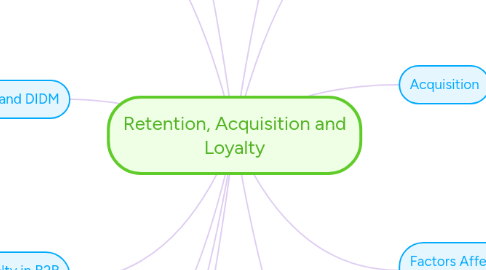Retention, Acquisition and Loyalty
por Charlotte Jobson


1. What is Loyalty
1.1. 'The hallmark of a brand is consumer loyalty and loyalty is what is left when you take the bribes away' Albeit 2005
1.2. Reichheld 1996 found
1.2.1. 50% customers lost over 5 years
1.2.2. 50% employees lost over 4 years
1.2.3. 50% investors lost in year 1
2. Loyalty Ladder
2.1. 1. Partner
2.2. 2. Advocate
2.3. 3. Convert
2.4. 4. Honeymooner
2.5. 5. Customer
2.6. 6. Prospect
2.7. 7. Suspect
3. Loyalty and DIDM
3.1. Allows targeting of most valuable, most intrinsically loyal customers
3.2. Helps to create loyalty by developing customer relationships
3.3. Take advantage of relationships to market to individuals as individuals
3.4. DIDM can measure retention costs, spends and LTV
4. Segmenting by Loyalty in B2B Markets
4.1. Programmed Buyers - Small customers, less price sensitive, purchasing is a routine
4.2. Relationship buyers - Small, more knowledgeable, seek partnerships
4.3. Transaction Buyers - Larger customers, very knowledgeable, seek partnership
4.4. Bargain Hunters - Large customers, switch suppliers readily, price/service sensitive
5. Types of Loyalty
5.1. Emotional, resented, active, momentum, personal, image
6. Types of Bonds with Customers
6.1. Financial Bond - Money off, points mean prizes
6.2. Structural Bond - Membership, contract, continuous payment
6.3. Emotional Bond - Understand me, recognise me, say something about me
7. Perceptions and Emotions Drive Loyalty
7.1. Milliard Brown (2010) 5x more likely to defect if we feel ignored, pushed around or badly treated. Angry/disappointed customers are likely to tell 2-5x more people about their experience
8. Retention
8.1. 1% improvement in customer retention leads to 5% increase in company value
8.2. 1% reduction in customer acquisition costs leads to 1% increase in company value
8.3. Retention 5 times more valuable than cost cutting
9. Why Retention Leads to Higher Profits
9.1. No acquisition costs - Already have the customer
9.2. Price premium - Existing customers pay more, don't shop around and ignore offers
9.3. Referrals - Satisfied customers give free referrals
9.4. Revenue growth - Loyalty leads to greater propensity to buy greater amount of stuff
10. Acquisition
10.1. Act of acquiring new customers through
10.1.1. Cold lists - profiling shows there's been an interest
10.1.2. Customers of parent/sister company
10.1.3. Customers of strategic partner
10.1.4. Lapsed customers
10.1.5. Enquirers
